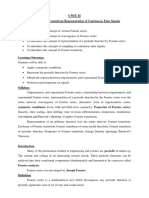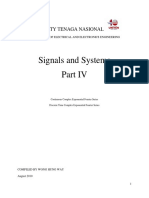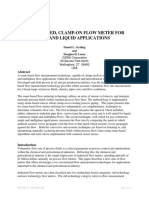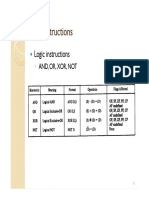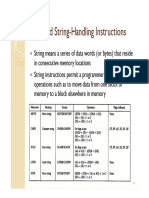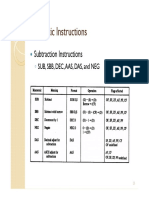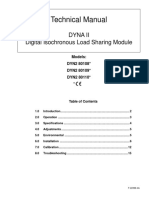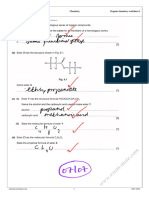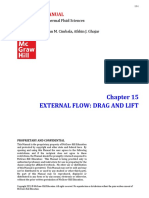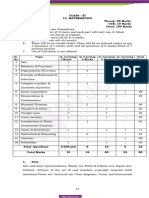Chapter Two
Fourier Transform and Fourier Series
Any signal could be represented in frequency domain as a function of frequency and
determine its spectrum. For periodic signals, a Fourier Series is used, while Fourier
transform is used for aperiodic signals.
Fourier Series
A Fourier series is an expansion of a periodic function in terms of an infinite sum
of sines and cosines. Fourier series make use of the orthogonality relationships of the
sine and cosine functions. The computation and study of Fourier series is known as
harmonic analysis and is extremely useful as a way to break up an arbitrary periodic
function into a set of simple terms that can be plugged in, solved individually, and
then recombined to obtain the solution to the original problem.
Trigonometric Fourier Series
It is known that x(t) can be presented over any interval (to, to+T) by:
x(t) = Co + C1 x1(t) + C2 x2(t) + ………
such that x1(t), x2(t), …. are functions forming orthogonal set over that interval. If
these functions are chosen to be sine and cosine, then the trigonometric Fourier Series
is expressed as:
( )= + ∑ ( cos + sin )
To calculate Fourier Series Coefficients
= ∫ ( )
= ∫ ( ) cos
= ∫ ( ) sin
The frequency ωo is called fundamental frequency, while (nωo) is the nth harmonic.
To is period of the signal x(t). ωo=2π/ To.
The trigonometric Fourier Series can be expressed in COMPACT FORM as:
1
Dr. Emad Al-Mohammed
�Chapter Two
( )= + ∑ cos( + )
= +
= tan ( )
The Compact Fourier Series is useful to specify the single sided spectrum.
Exponential Fourier Series
Any periodic signal could be expanded using the exponential Fourier series which is
expressed by:
( )=∑ −∞ < <∞
= ∫ ( )
Example
To understand the Fourier series and its fundamental and harmonics, find the three
forms of Fourier series for the signal below. What is the fundamental frequency?
( ) = −1 − 2cos ( − )
Solution
The signal is expressed in terms of sinusoid, so we don't need to evaluate any integral.
The fundamental frequency is ωo = 2π/6 (fo = 1/6)
a- Compact trigonometric form
( ) = −1 − 2 cos − = −1 + 2 cos + + = −1 + 2 cos( + )
Co = -1, C1 = 2, θ1 = 2π/3
b- Exponential form
( ) ( )
( ) = −1 + +
2
Dr. Emad Al-Mohammed
�Chapter Two
Co = -1, C1 = 1, C-1 = 1, θ1 = 2π/3, θ-1 = 2π/3
c- Trigonometric Fourier series
( ) = −1 − 2 cos − = −1 − 2 cos cos − sin sin = −1 −
cos − √3 sin
ao = -1, a1 = -1, b1 = - √3
Example
Find the trigonometric Fourier Series over a period (0, 1), where
x(t) = At for 0 < t < 1
Solution
= ∫ ( ) =∫ =
= ∫ cos 2 =2∫ cos 2 =0
= ∫ sin 2 =2∫ sin 2 =
( )= − ∑ 0< <1
Example
Find the exponential Fourier Series for Full-wave rectified sine wave
x(t) = A sin πt 0<t<1
and x(t+m) = x(t), m is integer.
x(t)
Solution
A
To = 1, ωo = 2π/ To = 2π/1 = 2π
( )=∑ =∑
-1 0 1 2 3
=∫ sin = ( )
3
Dr. Emad Al-Mohammed
�Chapter Two
( )= ∑
= , = = , = = , … ….
Cn
2A/π
2A/3π 2A/3π
2A/15π 2A/15π
ω
4π- 2π- 2π 4π
Θn
180 180
4π- 2π- ω
2π 4π
-180 180-
Note
= ∫ ( )
Thus, Cn and C-n form a complex conjugate pair, that is C-n = Cn* , hence |C-n| = |Cn|
and if Cn = |Cn| ejarg[Cn], then, C-n = |Cn| e-jarg[Cn] , So
arg[C-n] = -arg[Cn]
where arg[Cn] is the phase of Cn which leads to that the phase spectrum is anti-
symmetrical (an odd function), while the magnitude spectrum is symmetrical (even
function) about the vertical axis passing through the origin.
Example
Find the exponential Fourier Series expansion and line spectra for the rectangular
pulse train (periodic Gate) shown below:
4
Dr. Emad Al-Mohammed
�Chapter Two
− /2 < < /2
( )= x(t)
0 < < − /2
A
And x(t+mTo) = x(t)
Solution -To + τ/2 τ/2- 0 τ/2 To - τ/2
1
= ( )
/
1
= ( )
/
/
1 − 2 = 2
= = sin
−2 2
/
sin /2
= [ ]= ( )
/2 2
|Cn| = Aτ/To |Sa(nωoτ/2)|
5
Dr. Emad Al-Mohammed
�Chapter Two
where the lines of the spectrum are located at multiple 1/To while the zeroes are
located at multiple 1/τ. In the figure above, the duty cycle is specified as 1/4.
Therefore, the first zero located at the forth line in the spectrum diagram which is 1/τ.
Notes
- Fourier series expansion expresses the signal in terms of its components of
various frequencies. A periodic signal x(t) with period To has frequency
components of angular frequencies ωo, 2ωo, 3ωo, ….. nωo where ωo = 2π/ To.
Thus, the periodic signal x(t) possesses its spectrum of frequencies. Thus, by
specifying x(t), we can find its spectrum and vice versa. Therefore, we have
two ways to specify a periodic signal x(t), the time domain representation
where x(t) is expressed as a function of time, and the frequency domain
representation where the spectrum (that is the amplitude of various frequency
components) is specified as a function of frequency.
- The spectrum is exist only at ωo, 2ωo, 3ωo, ….. nωo. Thus, the spectrum is not a
continuous curve but exist only at some discrete values of ω. This is therefore
the reason why sometimes referred to the spectrum as a line spectrum.
- We may uses the trigonometric series, but the exponential form, however,
looks more useful for our purpose of study.
- The idea of the negative frequencies is not hard to be understood. Both signals
ejωt and e-jωt oscillates at frequency ω. They may be looked upon as two
phasors rotating in opposite directions and when they added, the result yields a
real function of time. Thus,
+ = 2 cos
Since, for the periodic signals, x(t) is:
( )= −∞< <∞
Thus we have frequencies 0, ±ωo, ±2ωo, ±3ωo, …… ±nωo, and the amplitudes
of these components are Co, C1, C2, C3, C-1, C-2, C-3 ……. Cn, C-n,
respectively. The magnitudes Cn are usually complex, then, they can be
described as magnitude and phase. Therefore, generally, we need two line
6
Dr. Emad Al-Mohammed
�Chapter Two
spectrum, the magnitude and phase spectrum for frequency domain
representation.
Proof
If x(t) is a real function, prove that:
( )= +∑ |2 | cos( + arg [ ])
Solution
( )=∑
Since x(t) is real, then C-n = Cn* and arg[C-n] = -arg[Cn]. by re-arranging the above
expression:
( )=∑ + +∑ = ∑ + +
∑ ( [ ]) ( [ ])
= ∑ | | + +∑ | | =
( [ ]) ( [ ])
+∑ |2 |[ ]= +∑ |2 | cos( +
arg[ ])
Example
Find the compact trigonometric Fourier series for the signal x(t). Sketch the amplitude
and phase spectrum.
x(t)
1
e-t/2
π t
π- 0 π2 π3
Solution
In this case the period To = π, and the fundamental frequency fo = 1/ To = 1/ π Hz. The
radian frequency ωo = 2π/To = 2. Therefore,
( )= +∑ cos(2 )+ sin(2 )
7
Dr. Emad Al-Mohammed
�Chapter Two
/
= ∫ = 0.504
( ) cos(2 ) /
= ∫ = ∫ cos(2 ) = 0.504 ( )
( ) sin(2 ) /
= ∫ = ∫ sin(2 ) = 0.504 ( )
= = 0.504
= + = 0.504(√ )
= tan = − tan 4
( ) = 0.504 + 0.504 ∑ cos(2 − tan 4 )
√
n Cn θn Amplitude
1 0.504 0
0.504
2 0.244 -75.96 0.244
0.125
3 0.125 -82.87
ω
4 0.084 -85.24 2 4 6 8 10
5 0.063 -86.42
6 0.05 -87.14
2 4 6 8 10 ω
7 0.042 -87.61
-75.96
-82.87
-85.24
Phase
( ) = 0.504 + 0.244 cos (2 − 75.96) + 0.125 cos (4 − 82.87)
+ 0.084 cos (6 − 85.24) + ⋯
Example
Find the compact trigonometric Fourier series for triangular signal x(t) that shown
below and sketch the amplitude and phase spectrum.
8
Dr. Emad Al-Mohammed
�Chapter Two
x(t)
A
t
-1 -0.5 0.5 1
-A
Solution
In this case, the period is To = 2, then, ωo = 2π/2 = π.
( )= +∑ cos( )+ sin( )
2 | | < 1/2
Where ( ) =
2 (1 − ) 1/2 < < 3/2
/ /
= ∫ /
2 + ∫ / 2 (1 − ) =0
/ /
= ∫ ( ) cos( ) =∫ /
2 cos( ) + ∫ / 2 (1 − ) cos( )
Solving these integrals shows that both have a value of zero. Therefore, an = 0. Note
that x(t) is odd function, so, the integral of odd function is zero.
/ /
= ∫ ( ) sin( ) =∫ /
2 sin( ) + ∫ / 2 (1 − ) sin( )
= sin( /2)
( )= (sin − sin 3 + sin 5 − 7 +⋯)
8 1 1 1
( )= [cos( − 90°) + cos( 3 + 90°) + cos( 5 − 90°) + cos (7
9 25 49
+ 90°) + ⋯ ]
Amplitude
2
π8A/
8A/9π2
8A/25π2
8A/49π2 ω
π π3 π5 π7
9
Dr. Emad Al-Mohammed
�Chapter Two
Phase
90o
ω
π π3 π5 π7
-90o
H.W.
1. Find the exponential Fourier series for the periodic signals shown below. Sketch
the amplitude and phase spectra.
x(t)
t2
t
-2 -1 1 2 3
2. Find the compact trigonometric Fourier series for the periodic signals shown below.
Sketch the amplitude and phase spectra.
x(t)
t
-2 -1 1 2 3
-A
Example
A periodic signal x(t) is represented by trigonometric Fourier series
x(t) = 2 + 3 cos 2t + 4 sin 2t + 2 sin (3t+30o) – cos (7t+150o)
Express this series as a compact trigonometric Fourier series and sketch the amplitude
and phase spectra for x(t).
10
Dr. Emad Al-Mohammed
�Chapter Two
Solution
ωo = 1, a2 = 3 and b2 = 4,
= + = √9 + 16 = 5 = tan = tan =
−53.13
( ) = 2 + 5 cos(2 − 53.13°) + 2 cos(3 − 60°) + cos(7 − 30°)
Amplitude
5
2 2
1 ω
2 3 7
Phase
2 3 7 ω
-30o
-53.13o
-60o
H.W.
11
Dr. Emad Al-Mohammed
�Chapter Two
Fourier Transform
The Fourier transform (FT) decomposes an aperiodic function of time (a signal)
into the frequencies that make it up, The Fourier transform of a function of time is
itself a complex-valued function of frequency, whose absolute value represents the
amount of that frequency present in the original function, and whose complex
argument is the phase offset of the basic sinusoid in that frequency. The Fourier
transform is called the frequency domain representation of the original signal.
The Fourier transform of an aperiodic signal x(t) is symbolized by X() or Ƒ[x(t)] and
is given by:
( )=∫ ( )
And the inverse Fourier transform is given by:
( ) = Ƒ [ ( )] = ∫ ( )
Or we write ( ) ↔ ( ) and vice versa
Sometimes, we referred to X(ω) as a spectrum and it can be plotted as a function of
"ω" or "f". Since X(ω) is complex valued function, then it should be represented by
both amplitude and phase spectra, i.e.
( ) = | ( )| ( )
Where |X(ω)| is the amplitude and θx(ω) is the phase of X(ω)
Note:
If ( )=∫ ( )
Then (− ) = ∫ ( )
And if x(t) is real function, then X(ω) and X(-ω) are complex conjugate
X(-ω) = X*(ω)
Therefore, |X(-ω)| = |X(ω)| is even function and θx(-ω) = -θx(ω) is odd function.
12
Dr. Emad Al-Mohammed
�Chapter Two
Example
| | ≤ /2
Find the Fourier Transform of gate signal ( ) = = .
0 | | > /2
Solution
/ ( )
( )=∫ ( ) =∫ /
= = ( )
X(f)
A
f
-3/τ -2/τ -1/τ 1/τ 2/τ 3/τ
arg[X(f)]
180o
-3/τ -2/τ -1/τ
f
1/τ 2/τ 3/τ
-180o
Example
Find the Fourier Transform of single sided exponential ( ) = ( ).
Solution
( )=∫ =
( )= ( / )
( ) arg[X(f)]
π/2
X(f)
A/a
f
f
13 -π/2
Dr. Emad Al-Mohammed
�Chapter Two
Note
- The Fourier transform of unit impulse function δ(t)
Ƒ[ ( )] = ∫ ( ) = =1
Ƒ[ ( − )] = ∫ ( − ) =
- The inverse Fourier Transform of unit impulse function δ(ω)
Ƒ [ ( )] = ∫ ( ) =1
Ƒ [ ( )] = ∫ ( ) =
1↔2 ( )
↔ ( )
Ƒ [ ( − )] = ∫ ( − ) =
↔2 ( − )
↔ ( − )
- Fourier Transform of cos ↔ [ ( − )+ ( + )]
By knowing that ↔2 ( − ) and ↔2 ( + ) and using the
formula cos = 1/2( + )
π π
ω
o-ω oω
H.W.
Find the Fourier Transform of
| |
1.
−1 −1< <0
2. ( )=
1 0< <1
14
Dr. Emad Al-Mohammed
�Chapter Two
Fourier Transform Properties
1- Symmetry Property
( )↔ ( ) ℎ ( ) ↔ (− )
( )↔ ( ) ℎ ( )↔2 (− )
For example, if we want to find the Fourier transform of ( )= ( ), we can
apply the symmetry property by knowing that ↔ ( ), then
↔2 =2
Also 1 ↔ 2 ( ) which means 1/2 ↔ ( ) and 1 ↔ ( ) because ( ) ↔ 1.
As we know, Ƒ[ ( − )] = ∫ ( − ) = , then, the complex
sinusoid of frequency fo is
↔ ( − )
2- Linearity Property
( )↔ ( ) ( )↔ ( ) ℎ
( )+ ( )↔ ( )+ ( )
For example, to find Fourier transform of x(t) = cos ωot = cos 2πfot
( ) = . . [cos 2 ]= . . = ( − )+ ( + )
3- Time-Shifting Property
( )↔ ( ) ℎ ( − )↔ ( )
If the signal is shifted by "to" sec, then its magnitude spectrum |X(f)| remains
unchanged while phase spectrum is changed by an amount of (-2πfto).
/
For example, to find FT of ( )
↔ ( )
/
↔ ( ) = ( )
15
Dr. Emad Al-Mohammed
�Chapter Two
4- Frequency-Shifting Property
( )↔ ( ) ℎ ( ) ↔ ( − )
The multiplication of x(t) by ej2πfct translates the whole frequency spectrum X(f) by an
amount of fc. hence, this property is known as frequency translation theorem
(modulation).
Modulation is usually accomplished by multiplying x(t) by a sinusoidal signal. Since
( ) cos(2 )= [ ( ) + ( ) ]
( ) cos(2 ) ↔ [ ( − ) + ( + )]
Also ( ) (2 )↔ [ ( − ) − ( + )]
Example
Find F.T. of x(t) cos (2πfct) if x(t) is triangular pulse as shown below:
| |
1− | |≤
( )=
0 | |≥
t f
τ- τ -1/τ 1/τ
f
fc-1/τ- fc- -fc+1/τ fc-1/τ fc fc+1/τ
16
Dr. Emad Al-Mohammed
�Chapter Two
5- Differentiation and Integration Property
( )
( )↔ ( ) ℎ ↔ 2 ( )
( )
↔( 2 ) ( )
∫ ( ) ↔ ( )
Example
Find F.T. of ( ) = ( )
Solution
( )
= [ ( )] = [ ( )] + ( )
= [ ( )− ( )] + ( )=− ( )+ ( )
=− ( )+ ( )
Take the F.T. of both sides; we get
(2 ) ( )=− ( )+
∴ ( )=( )
H.W.
Using the differentiation property find the F.T. of ( ) = ( )
Example
Apply the Differentiation property to find Fourier transform of x(t) which is shown
below.
Solution
( ) = ( + 3) − 3 ( + 1) + 3 ( − 1) − ( − 3)
Take Fourier transform for both sides:
(2 ) ( )= −3 +3 − =2 (6 )−6 (2 )
( )= [2 (6 )−6 (2 )]
( )
17
Dr. Emad Al-Mohammed
�Chapter Two
x(t) x'(t)
2
1
t t
1 3
-3 -1 -3 -1 1 3
-2 -2
x''(t)
3
1
t
-3 -1 1 3
-1
-2
-3
Example
Find X(f) if x(t) = AΔ(t/τ)
Solution
x(t) x'(t)
A
A/τ
t t
-τ τ -τ τ
-A/τ
/ /
( )= ∏ − ∏
Take F.T. for both sides:
(2 ) ( )= ( ) − ( ) =2 ( ) sin( )
= ∗2 ( )
( )= ( )
18
Dr. Emad Al-Mohammed
�Chapter Two
H.W.
Q1/ Using differentiation property, find F.T. of x(t).
x(t)
−1 −1< <0 1
( )=
1 0< <1 -1
1 t
Q2/ Find X(f) if x(t) is shown below -1
x(t)
-a -b b a
1- Time Scaling Property
( )↔ ( ) ℎ ( ) ( )↔| ( / )
|
x(at) is a compressed version of x(t). the compression is in time scale by a factor of
"a". X(f/a) is an expanded version of X(f). The expansion in frequency is by the same
factor "a". Thus, the time scaling property states that :
compression in time → expansion in frequency
expansion in time → compression in frequency
Special case when a=-1, x(-t) ↔ X(-f)
Example
Find the Fourier Transform of x(t) = 3 sinc (4t)
Solution
From symmetry property
x(t) ↔ X(ω) and X(t) ↔ 2π x(-ω)
so, the sinc is transformed to a gate function, which means,
19
Dr. Emad Al-Mohammed
�Chapter Two
∏ ↔ ↔2 ∏ − =2 ∏
3 (4 ) = (8 ( )) X(ω)
3π/4
8 ↔ 2 ∏ = ∏
4- 4 ω
Parseval's Theorem
As the frequency-domain representation of a signal is an equivalent representation,
energy E of a signal can also be expressed in terms of its spectrum. Parseval's theorem
states that that the sum (or integral) of the square of a function is equal to the sum (or
integral) of the square of its transform. That's mean;
( )↔ ( ) ℎ
=∫ | ( )| =∫ | ( )| = ∫ | ( )|
= ∫ | ( )|
That's mean, the energy of x(t) is the same as the energy contained in X(f).
Note: For periodic signals (Line Spectrum), the total power using Parseval's Theorem
is represented by:
= + + + +⋯= + ∑
Note that, for exponential Fourier series, =∑
Example
Find the signal energy of x(t) = 10 sinc (5t)
Solution
By using Parseval's theorem, = ∫ | ( )| . So, we need X(ω)
↔2 ∏ , τ=10,
20
Dr. Emad Al-Mohammed
�Chapter Two
Therefore, ( ) = 2 ∏
= ∫ (2 ) =2 | = 20
Example
Find the energy of signal x(t) = e-at u(t). Determine the frequency W (rad/sec) so that
the energy contributed by the spectrum components of all the frequencies below ω is
95% of the signal energy.
Solution
We have, =∫ ( ) =∫ =
We can verify this result by Parseval's theorem. For this signal, ( ) = and
= ∫ = ∫ = tan ( ) |
= [tan ∞ − tan 0] = −0 =
The required band is between ω=0 to ω=W which contains 95% of the signal energy
1/2a, therefore,
0.95 ∗ = ∫ = tan
.
∴ = tan
.
= tan = 12.7 /
Example
For the periodic signal x(t) shown below, find the bandwidth that contains 88% of the
total signal power.
x(t)
10
1 2 5
-5
21
Dr. Emad Al-Mohammed
�Chapter Two
Solution
= ∫ ( ) = ∫ 10 +∫ 5 = 100 + 25 = 43.75
To calculate the power using Parseval's theorem, we firstly determined the
trigonometric Fourier series coefficients.
Co = -1.25
= + = sin
∴ = + + + +⋯ =
n Cn Pn
0 -1.25 1.56 1.56
1 6.75 22.79 24.36
2 4.78 11.39 35.78
3 2.25 2.53 38.31
4 0 0 38.31
5 1.35 1.91 39.22
So, to get 88% of signal power, the bandwidth should be include the fifth harmonic,
where 88% of the total power is 38.5. Then, W= 5ωo = 5 x 2π x 1/4 = 2.5 π
22
Dr. Emad Al-Mohammed






















